Trekking Shoes: The Ultimate Guide 2024
- Trekking Tips & Advice
-
Jun 08
- Share post
Trekking shoes are an essential piece of equipment for any outdoor enthusiast or adventurer. Whether planning a day hike or a multi-day expedition, having the right footwear can make a world of difference in terms of comfort, performance, and overall enjoyment of your trekking experience.
This guide will explore the different types of trekking shoes, factors to consider when choosing them, tips for proper fitting, and best practices for care and maintenance.
Table of Contents
ToggleWhy are Trekking Shoes Important?

Trekking shoes provide crucial support and protection for your feet while navigating challenging terrains. They are designed to provide stability, traction, and shock absorption, reducing the risk of injuries such as twisted ankles or blisters. Good shoes also offer durability and weather resistance, ensuring they withstand various outdoor conditions.
Different Types of Trekking Shoes

Hiking Shoes
Hiking shoes are lightweight and flexible, suitable for day hikes or less demanding terrains. They offer a good balance between comfort and support, with a lower cut allowing greater freedom of movement. Hiking shoes are ideal for those who prefer a more agile and fast-paced hiking experience. They are good for day hikes in Maharashtra like the Kalsubai trek, or the Salher fort trek.
Trail Running Shoes
Trail running shoes are similar to hiking shoes but designed for running on off-road trails. They are lightweight, provide excellent traction, and offer cushioning to absorb impact during high-intensity activities. Trail running shoes are a great option for those who want to combine trekking with trail running. Brooks Running, Hoka, On-Running & Saucony are some of the brands that make top quality trail running shoes.
Mountaineering Boots
Mountaineering boots are heavy-duty shoes designed for challenging terrains and extreme weather conditions. They provide maximum support, insulation, and durability. Mountaineering boots. They are good for multi-day hikes like the Tarsar Marsar trek or the Kuari pass trek.
Factors to Consider When Choosing Trekking Shoes
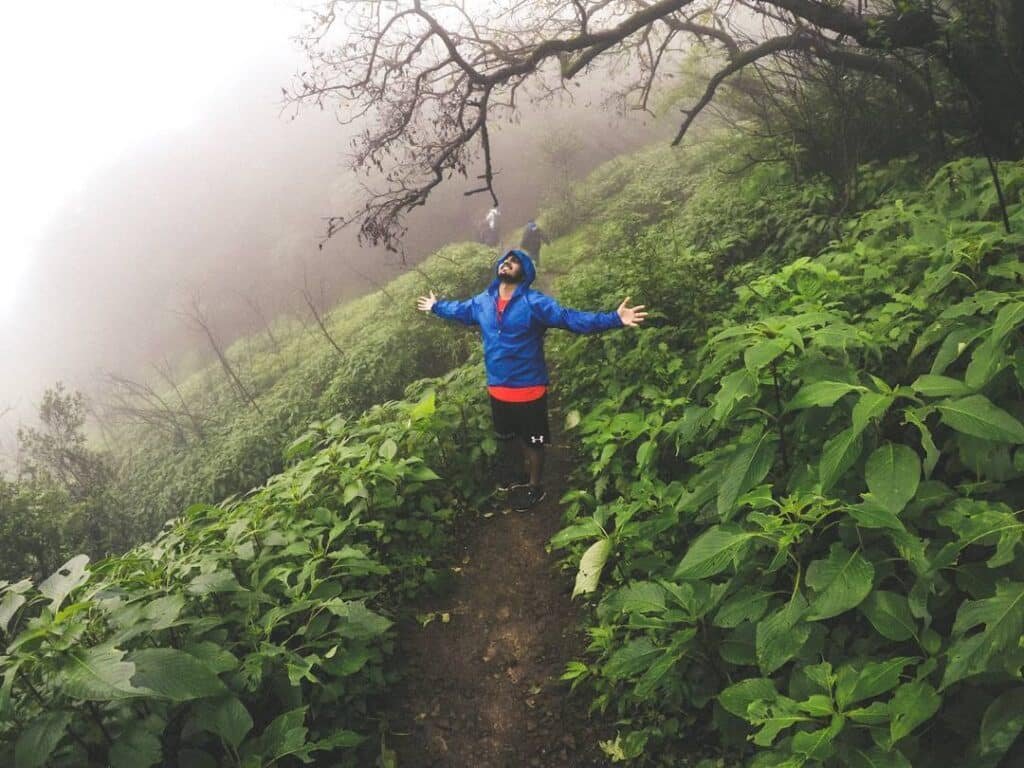
Selecting the right pair of trekking shoes involves considering various factors to ensure they meet your specific needs and preferences. Here are some essential factors to keep in mind:
Terrain
The type of terrain you’ll be trekking on plays a significant role in determining the appropriate shoes. Consider whether you’ll be walking on flat trails, rugged mountains, or slippery surfaces, and choose shoes with suitable traction and stability.
Weather Conditions
Consider the weather conditions you will likely encounter during your treks. Waterproof shoes with breathable membranes are recommended for wet environments. In contrast, well-ventilated shoes are preferable for hot and dry climates.
Durability
They should be able to withstand the rigours of outdoor activities. Look for shoes made from durable leather or synthetic fabrics with reinforced toe caps and robust outsoles.
Comfort and Fit
Comfort should be one of the key factors when choosing the perfect shoes. Ensure that the shoes fit snugly without any pressure points or excessive movement. Consider trying them on with the socks you plan to wear during your treks.
Weight
The weight of your trekking shoes can impact your overall comfort and performance. Lightweight shoes are suitable for shorter hikes or for those who prioritize speed. At the same time, heavier boots offer more stability and protection for longer and more challenging treks.
Understanding the Anatomy of Trekking Shoes

Understanding the anatomy and the components contributing to the performance of the trekking shoes is essential. The key components include:
Outsole
The outsole is the bottom part of the shoe that comes into direct contact with the ground. It should have a lug pattern designed for optimal traction on various terrains, such as mud, rocks, or snow.
Midsole
The midsole provides cushioning and support. It is typically made of foam or EVA (ethylene-vinyl acetate) and absorbs shock during walking or running.
Upper
The upper is the upper part of the shoe that covers the foot. It should be breathable and durable materials that protect the feet while allowing airflow to prevent overheating or moisture build-up.
Lacing System
The lacing system secures the shoes on your feet and allows you to adjust the fit. Look for shoes with a lacing system that provides a snug fit and prevents slippage during treks.
Tips for Properly Fitting Trekking Shoes
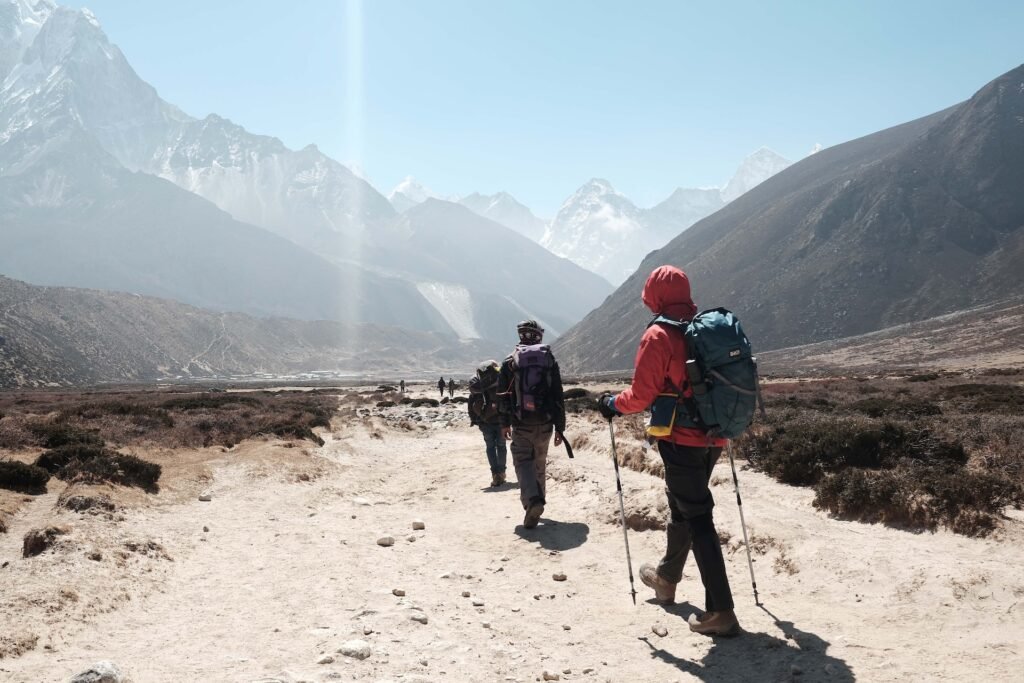
Properly fitting trekking shoes are essential for comfort and to prevent foot problems. Here are some tips to help you find the right fit:
Sizing and Length
Measure your feet accurately and refer to the manufacturer’s sizing chart to choose the correct size. Ensure that there is about a thumb’s width of space between your longest toe and the end of the shoe.
Width and Toebox
Consider the width of your feet and choose shoes that provide enough room for your toes to wiggle comfortably. A wide toebox can prevent blisters and toe-related injuries.
Arch Support
If you have high or low arches, look for shoes with appropriate arch support. This helps maintain proper foot alignment and reduces the risk of discomfort or pain during long treks.
Heel Lock
Ensure your heels are properly locked into the shoes to prevent slippage and blisters. Experiment with different lacing techniques to find the one that works best for your feet.
Break-in Period and Maintenance of Trekking Shoes
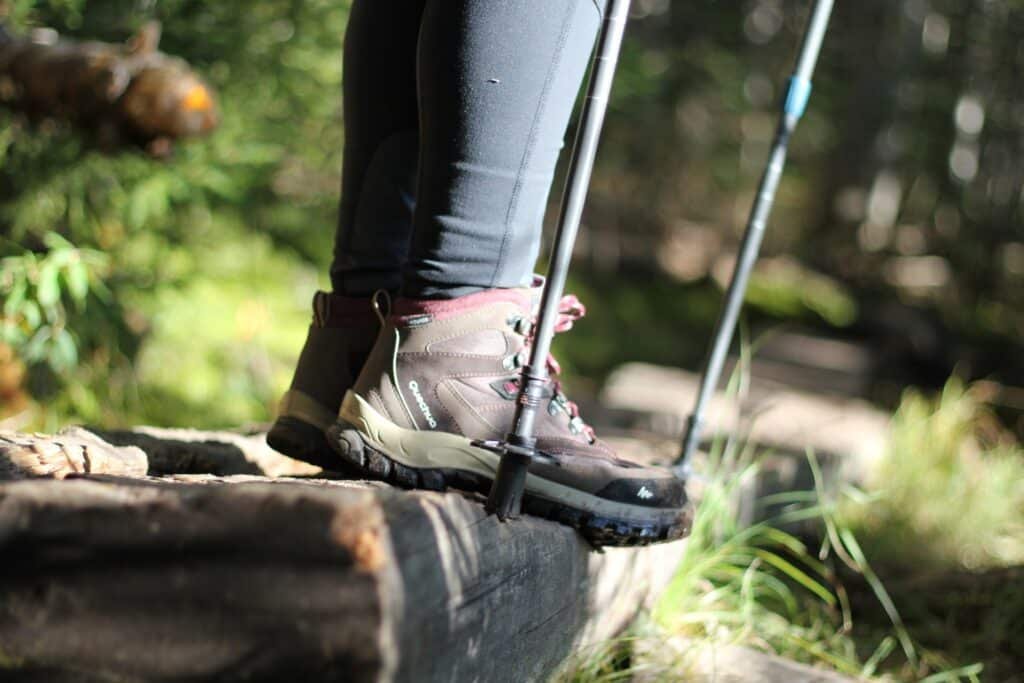
Before embarking on a long trek, it is crucial to break in your trekking shoes to avoid discomfort and blisters. Wear them around your house or on shorter hikes to allow the shoes to conform to your feet’ shape and soften up.
Best Practices for Trekking Shoe Care
Proper care and maintenance of your trekking shoes will prolong their lifespan and ensure optimal performance. Here are some best practices to follow:
Storing Trekking Shoes
Keep your trekking shoes in a cool, dry place, away from direct sunlight. Avoid storing them in damp areas, as moisture can cause the materials to deteriorate.
Regular Inspections
Inspect your trekking shoes before and after each trek. Check for any signs of damage, such as worn-out outsoles or loose stitching. Promptly address any issues to prevent further damage.
Repair and Replacement
If your trekking shoes sustain significant damage or show signs of extensive wear, consider getting them repaired or replaced. Worn-out shoes can compromise your safety and comfort during treks.
Best Budget Trekking Shoes for Day Treks
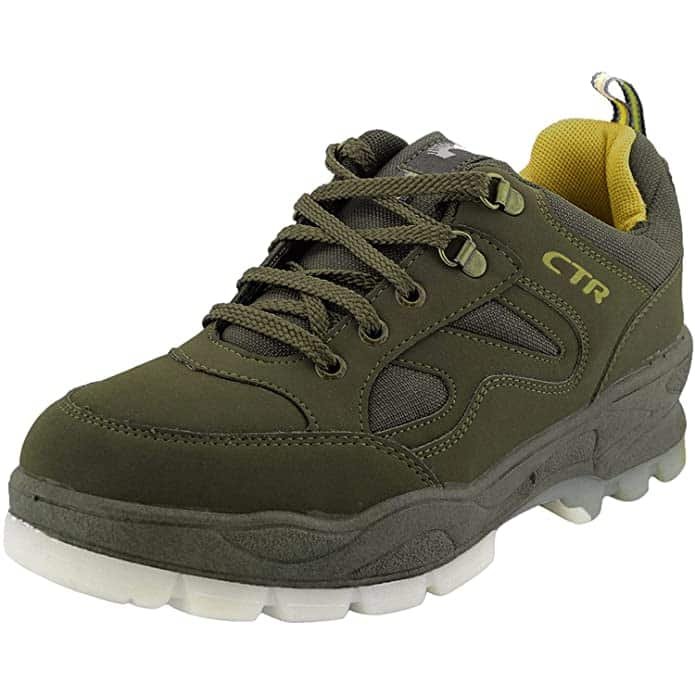
ADD GEAR CTR (INR 1,600)
The Add Gear CTR trekking shoes are a great choice for day treks in Sahyadris. They are lightweight and comfortable, with a durable rubber sole that provides good traction on wet and slippery surfaces. The shoes also have a breathable mesh upper that helps to keep your feet cool and dry.
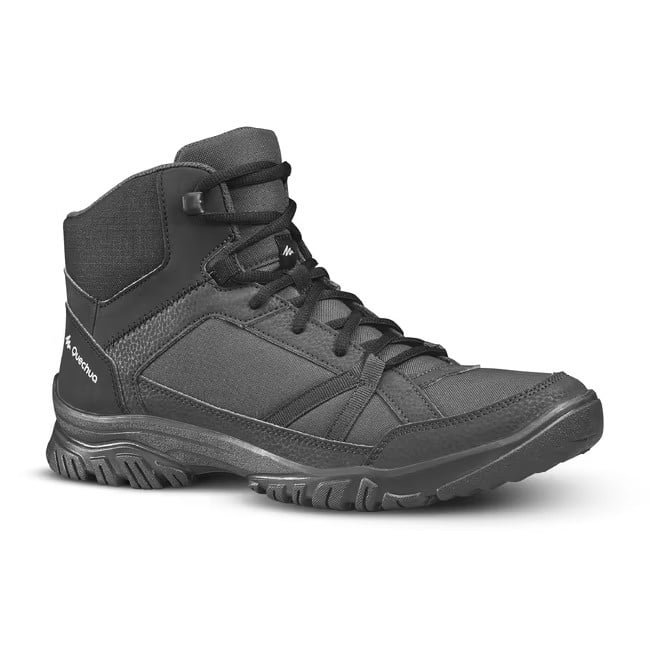
Quechua NH100 Mid(INR 1,500)
The Quechua NH100 Mid trekking shoes are a great option for budget-minded hikers. They are lightweight and comfortable, with a durable rubber sole that provides good traction on most terrain. The shoes also have a breathable mesh upper that helps to keep your feet cool and dry.
They are also a good options for travel in the Himalayas. There are both men's & women's options.

Wildcraft Volga NX
(INR 1,999)
The Quechua NH100 Mid trekking shoes are a great option for budget-minded hikers. They are lightweight and comfortable, with a durable rubber sole that provides good traction on most terrain. The shoes also have a breathable mesh upper that helps to keep your feet cool and dry. They are also a good options for travel in the Himalayas. There are both men's & women's options.

Power Lionel Outdoor Shoes (INR 1,000)
The power Lionel Outdoor shoes have a soft rubber sole making it a good companion for monsoon treks in the Western ghats. The lugs on the soles of the shoes are appropriately sized making them ideal for monsoon day treks.
Best Trekking Shoes for Multi-Day Treks
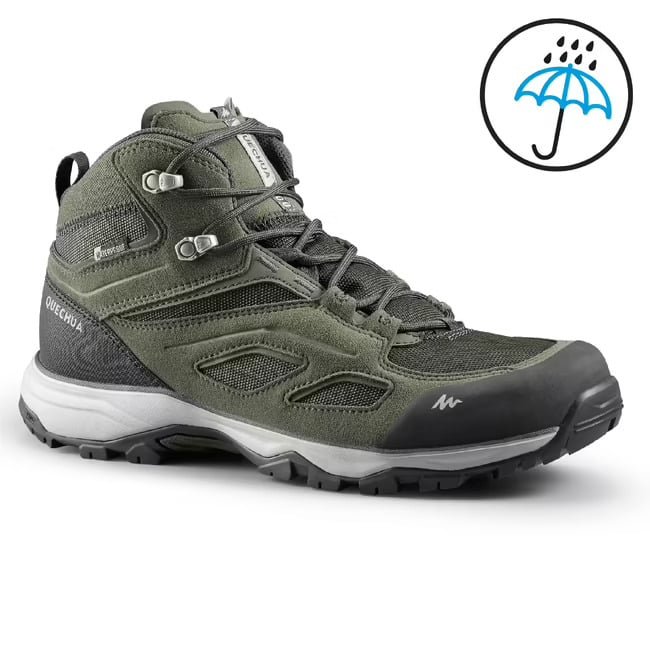
Quecha Waterproof MH100 (INR 4,500)
The Quechua Waterproof MH100 trekking shoes are perfect for outdoor enthusiasts. These shoes offer waterproof protection, ensuring your feet stay dry in wet conditions. With their rugged outsole and cushioned sole, they provide excellent traction and comfort, making them ideal for various terrains and long hikes.

Wildcraft HYPAGRIP RuNX Hugo (INR 4,000)
The Wildcraft HYPAGRIP RuNX Hugo trekking shoes are designed for adventure enthusiasts. With excellent grip and durability, these shoes provide comfort and stability on various terrains. They feature a lightweight build, breathable materials, and a cushioned sole, making them ideal for long hikes and treks.
Conclusion
Choosing the right trekking shoes is crucial for a comfortable and enjoyable trekking experience. When selecting your shoes, consider the terrain, weather conditions, durability, comfort, and fit. Understand the anatomy of trekking shoes and follow proper fitting techniques to ensure a snug fit.
Break in your shoes before embarking on long treks and practice regular care and maintenance to prolong their lifespan. Invest in high-quality trekking shoes to enhance your outdoor adventures and keep your feet happy and protected.
FAQs
It is recommended to wear trekking shoes specifically designed for outdoor activities. These shoes provide durability, support, and traction needed for challenging terrains.
A trekking shoe is a type of footwear designed for hiking and trekking adventures. It offers features like sturdy construction, ankle support, and a grippy outsole to ensure comfort and stability during outdoor activities.
Trekking shoes provide several benefits, including superior traction on rugged surfaces, ankle support to prevent injuries, durability to withstand rough terrains, and comfort for long hours of trekking.
The main difference lies in ankle support and flexibility. Trekking boots offer higher ankle support for challenging terrains, while hiking boots provide more flexibility for less demanding trails. Both offer durability and grip suitable for outdoor activities.
Comments
Add a comment
Leave a Reply · Cancel reply
This site uses Akismet to reduce spam. Learn how your comment data is processed.

Sar Pass Trek: A Thrilling Himalayan Adventure - Nomads of India
June 9, 2023 at 2:17 pm[…] Related Articles: Your Ultimate Guide to Buying Trekking Shoes for Epic Expeditions & Treks! […]
Shrikhand Mahadev Trek: An Adventurous Journey - NOI
June 12, 2023 at 12:09 pm[…] Trekking shoes with good ankle support […]
Buran Ghati Trek: A Thrilling Mountain Escape - Nomads of India
June 14, 2023 at 4:05 pm[…] Sturdy trekking shoes […]
Bali Pass Trek: Exploring the Majestic Himalayan Trail - NOI
June 14, 2023 at 11:34 pm[…] Trekking shoes with good ankle support […]
Kuari Pass: Ultimate Trek Guide 2023 - Nomads of India
June 15, 2023 at 12:00 am[…] Sturdy trekking shoes […]
Kashmir Great Lakes Trek: Ultimate Guide - Nomads of India
June 16, 2023 at 12:06 am[…] Trekking shoes with good ankle support […]
Kalavantin Durg Trek: Ultimate Guide - Nomads of India
June 16, 2023 at 12:14 am[…] on your trekking shoes, pack your backpack, and prepare for an unforgettable journey to Kalavantin […]
Kareri Lake Trek: The Ultimate DIY Guide - Nomads of India
June 18, 2023 at 5:47 pm[…] proper trekking shoes to avoid […]
Harihar Fort Trek Ultimate Guide (2023) - Nomads of India
June 28, 2023 at 11:06 am[…] sufficient water and wearing comfortable trekking shoes for this adventure are essential. Beginners may find this trek moderately difficult, but it is […]
Sondai Fort - 6 things you need to know for the perfect beginners trek - Nomads of India
June 28, 2023 at 3:17 pm[…] Sturdy trekking shoes for a comfortable and safe trek […]
Aadrai Jungle Trek - 5 Important things you need to know
June 28, 2023 at 9:07 pm[…] Sturdy trekking shoes for a comfortable and safe trek […]
Rupin Pass Trek: Unleash the Thrill of the Himalayas - Nomads of India
June 29, 2023 at 12:04 am[…] Trekking shoes with good ankle support […]
Garbett Plateau - Everthing You Need To Know - Nomads of India
June 29, 2023 at 11:26 am[…] Sturdy trekking shoes for a comfortable and safe trek […]
Kumara Parvatha Trek - Complete Guide (2023) - Nomads of India
June 30, 2023 at 9:49 am[…] Sturdy trekking shoes for a comfortable and safe trek […]
Kudremukh Trek: Your Ultimate Adventure Guide! - Nomads of India
July 2, 2023 at 11:42 pm[…] Sturdy trekking shoes for a comfortable and safe trek […]
Ettina Bhuja trek - 6 things you need to know - Nomads of India
July 2, 2023 at 11:44 pm[…] Sturdy trekking shoes for a comfortable and safe trek […]
Bandaje Falls Beautiful Trek - 5 Important Things You Need To Know
July 2, 2023 at 11:45 pm[…] Sturdy trekking shoes for a comfortable and safe trek […]
Epic Adventure Awaits: The Ultimate Goechala Trek Guide - NOI
July 4, 2023 at 5:08 pm[…] Trekking shoes with good ankle support […]